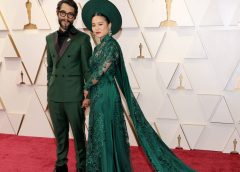
5 Asian Designers Bringing Traditional Dress to Modern Fashion
[ad_1]
- For centuries, Asian fashion has been appropriated by Western designers.
- Asian designers talked to Insider about how traditional garments influenced their works, from the cheongsam to the áo dài to the kurta.
- Designers discussed the importance of promoting Asian-inspired clothing.
Áo dàis, cheongsams, samfus, and hanboks aren’t only reserved for Lunar New Year anymore.
Representative Marilyn Strickland wore a hanbok, a traditional Korean dress, as she was sworn into Congress in 2021.
Actress Kelly Marie Tran, who has starred in movies like “Raya and the Last Dragon” and the Star Wars franchise, graced the 2022 Oscars red carpet in a glimmering emerald áo dài, a traditional Vietnamese dress.
“To have my name authentically ‘Thai Nguyen’ and then having that áo dài on the world’s biggest red carpet, it’s proud,” the dress’s designer, Thai Nguyen, told Insider.
Having that kind of authentic representation on a red carpet can have lasting ripple effects. Nguyen said when a follower’s daughter first saw Tran wearing an áo dài to the 2021 virtual “Raya” premiere, she instantly grabbed her own áo dài from her closet. Her mother said she didn’t want to wear Cinderella dresses anymore.
“It woke me up, and it woke our community up,” Nguyen said.
A model wears an outfit designed by John Galliano for Christian Dior’s Spring-Summer 2003 Haute Couture collection
Pierre Verdy/AFP via Getty Images
Cultural appropriation of Asian fashion has existed for centuries
Throughout history, Western nations and luxury fashion houses have fetishized Asian cultures through their garments. That hasn’t stopped in recent years.
Until 2020, retailer Pretty Little Thing’s website sorted qipaos complete with leg-slits under the “Oriental” category.
In the luxury fashion space, Dolce & Gabbana canceled what was to be the biggest show in the house’s 33-year-history after airing commercials of a narrator ridiculing an Asian model for using chopsticks to eat pizza and cannoli.
During a 2003 Christian Dior show, a white model walked wearing geisha-style makeup and a ballooning, silk dress. That same year, Roberto Cavalli designed a leg-revealing mini qipao — Kim Kardashian would later wear one boarding a plane in 2019.
The history of appropriating Asian garments is long. The Silk Road first brought Chinese silk and fabrics to Europe beginning as far back as 130 B.C.E. As centuries went on, European royals and elites would seek out the intricate embroidery for their court dresses and ball gowns. It eventually spun out to create its own, fusionized aesthetic: Chinoiserie.
Rihanna at The Met Gala in 2015 celebrating “China: Through the Looking Glass” on Monday, May 4, 2015, in New York.
Charles Sykes/Invision/AP
A history in seams
After creating the gown that rocked 2015’s Met Gala, Guo Pei became a global name. Photos of Rihanna wearing the yellow, fur-lined dress with a 16-foot-train took over the internet, making the Chinese designer a hot topic.
Pei spent her decades-long career reviving China’s revered art of embroidery — which, under the Cultural Revolution, was forbidden in the country — stitching dizzying threads etching what she calls the “DNA of a nation” into her work.
“The embroidery and skillset involved is not necessarily just some sort of a rote recovery of the past, but it also is a combination with my own imagination and also a connection to the textile culture of the world,” Pei told Insider, through a translator.
Rihanna’s 2015 Met Gala dress weighed 55 pounds. The threads themselves took over 50,000 hours of hand embroidery to make.
“It carries thoughts and spirits of the Chinese people. And it also is one of the languages of the culture that I was born and grew up in,” Pei said.
A symbol of women’s liberation gets a modern twist
Like Pei, Cheryl Leung draws on Chinese tradition through her fashion label, Sau Lee.
“I was really just inspired by my upbringing in Hong Kong,” Leung told Insider. “It was actually over the years that I really developed a sense of wanting to represent my culture and realizing that I’m not seeing it anywhere.”
While Leung emphasized there are other retailers who create traditional cheongsams — a close-fitting dress style that originated in 1920s Shanghai as a symbol of women’s liberation — her label aspired to “add cheongsam elements to international designs.”
The cheongsam is one of the most appropriated pieces of traditional Asian clothing. Thus, Leung said it’s important her designs avoid evoking fetishized stereotypes.
“I wouldn’t design anything that I wouldn’t wear as an Asian woman,” Leung said. Her spin on modernizing the garment might mean using jacquard in lieu of the traditional embroidered silk, or attaching buttons in an asymmetric silhouette. These modern pieces have become Sau Lee’s best-sellers.
“It is so empowering that these Eastern designs are so widely appreciated,” Leung told Insider.
‘Code-flexing’
Nyla Hasan’s brand, the øther, was born to challenge strict, cultural boundaries.
Inspired by Hasan’s South Asian roots, the brand brings kurtas — a loose, collarless tunic — to everyday, Western fashion.
“The øther kind of came from this amalgamation exploring identity, what it means to be mixed, what it means to be American,” Hasan told Insider.
Nyla Hassan, creator of the øther
Bianca Alexis
Hasan returned to the United States after the events of September 11th. After she finished her schooling, Hasan said, she had “a little bit of an edge where I didn’t give a shit if I belonged or not.”
She began wearing kurtas and jeans to school, popular among South Asian teens.
While a traditional kurta is often simple and boxy, Hasan’s version plays with garment, adding silk, high-low shirttails, or fully-split sides. One of Hasan’s kurtas even includes a hidden belt.
Hasan said she sees the øther as her way of “code-flexing” — as she describes, “the harmonious state of being, not conforming to a space, but choosing how to flex our identity in the spaces we exist in.”
No longer ‘too’ anything
As one of the few Vietnamese designers in high fashion, Nguyen said he is “proud, proud, proud.” But, only five years ago, he said he would struggle to say the same.
After leaving his job at the fashion brand BCBG, Nguyen said he was constantly shut down for not following “mainstream rules.”
“I wanted to follow my roots,” Nguyen said. “I wanted to put the áo dài in my collection. And then they’ll be like, ‘No, that’s too ethnic. That’s too Vietnamese.'” The Vietnamese dress is similar to a cheongsam, but is worn with long pants and features a full side-slit.
Now, Nguyen designs gowns for the likes of Ariana Grande, Sarah Hyland, and Laverne Cox, to name a few.
His Hollywood looks, while Western, present subtle nods to the áo dài: a high, collared neck and full sleeves, a long, straight skirt.
Nguyen says his pieces are the “East silhouette with Western fabrication.” To Nguyen, the áo dài is contemporary.
Of wearing áo dài to an event, Nguyen said “I don’t want people to have that question anymore.”
Updating ‘Grandma’s favorite wardrobe staple’
Trixie Chua, co-founder of dear samfu, found inspiration in her grandmother’s wardrobe.
“Asian women of the past used to wear [samfus] a lot, but it’s not so well-known,” Chua told Insider. “So we decided to really shine a spotlight on it.”
Trixie Chua’s grandmother (right) wearing a samfu
Trixie Chua
“Samfu” simply means shirt and pants. The timelessness of this Chinese fashion staple is the foundation for the brand. It’s a comfortable version of the “t-shirt and jeans.”
More deeply than the simplicity, Chua said dear samfu celebrates heritage. Not only is the brand dedicated to “grandma’s fashion” creatively, it is also sustainable. Sustainability, Chua said, before it became a buzzword, was practiced by her ancestors.
Cathy Liu, a dear samfu customer, purchased her piece because it was an homage to her Chinese heritage.
“As I get older, I’m embracing my Chinese heritage more. And so just being able to wear something like a samfu out in public is something that I’m glad I can do now,” Liu told Insider.
Liu posts collections of her daily outfits on Instagram — many posts featuring the samfu.
“Over time, I’ve just noticed there’s such a lack of Asian-inspired clothing in the Western world. And so I really wanna be able to promote it when I can to other people,” Liu said.
[ad_2]
Source link


